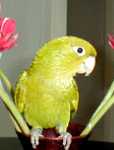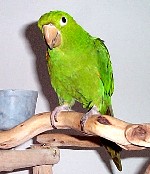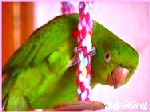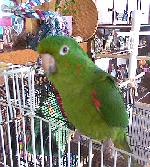Welcome to the
White-Eyed Page!
|
Name:
|
Name: Toby |
Name: Ziggy |
|
Name: Cosmo
|
Name: Nala |
Name: |
Name: White-Eyed Conure (Aratinga Leucophthalma)
Description: Mostly green, slightly lighter on breast and abdomen. There are a few scattered red feathers on the head. Bend and edge of wing, as well as outermost lesser wing-coverts, are red. Greater under wing-coverts are yellow. Underside of wing and tail feathers are olive-yellow. The Periophthalmic Ring is whitish and the Iris is brown. Their feet are grey and their beak is horn-coloured. Average length is 32 cm (12.5 inches) with a wing length of 166 - 188 mm (6.5 - 7.5 inches). Immatures have little or no red and the Iris is dark. All Conures are not sexually dimorphic and must be DNA or surgically sexed.**
In The Wild: Lives in pairs and family groups, with larger groups consisting of 10 to 20 birds, or flocks of up to 200 birds. They are nomadic, occasionally living with, or near, Blue-Crowned Conures (Aratinga Acuticaudata). Are known for being noisy and are deafening on roosting trees, where hundreds gather.
Breeding Information: Breeding season usually begins in May. A clutch usually consists of 3 to 4 eggs. The incubation period is an average of 23 days with a fledging period of approximately 50 days. Two breedings a year are possible. Their eggs measure 31.0 x 25.0 mm (1.22 x 0.98 inches).
Temperament: They are a lively Conure, medium-noisy to noisy. Imported birds are mostly shy. Becomes accustomed to their owner slowly. Hardy when acclimatised. They are very hard chewers and a constant supply of fresh branches are recommended. They enjoy bathing. May screech on approach of strangers.**
Diet: This should consist of Pellets, a good Seed Mix (Safflower, Oats, some Sunflower--also sprouted--Hemp, Buckwheat, Canary Seed and Rowan Berries), lots of Fruit, Vegetables, and Greens. A regular supply of branches with flowers and buds are also recommended. Diets may vary so you should consult your Avian Veterinarian.
** (Please note that not all birds are the same and may vary somewhat in Temperament and Plumage.)
Created by Rio
Designs
Champaign, Illinois



